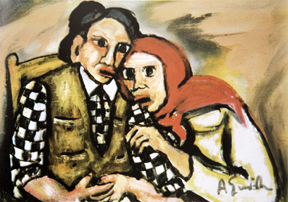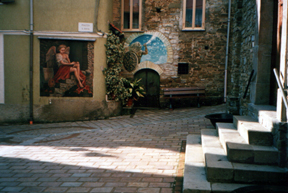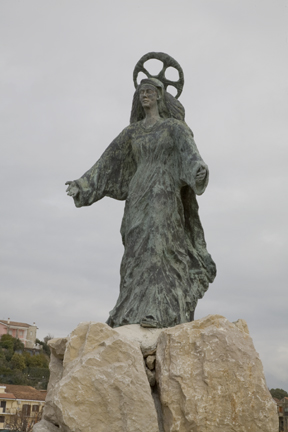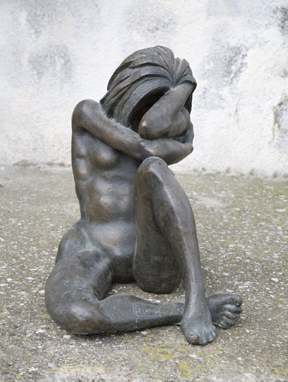
Raymond J. Steiner, Editor • Cornelia Seckel, Publisher
(845) 246-6944 · info@ArtTimesJournal.com
Art and Artists in Cilento
By ELSE MOGENSEN
ART TIMES April 2008
 Andres Guida Disperazione. Oil on canvas. 50 cm x 70 cm. |
Entering
the main piazza of Piano Vetrale, you notice an old man is sitting
on a bench with his newspaper and his little white dog. Is he real?
No, there is a signature telling us that he was painted by M. Giglio
in 1989. A little further on two surreal spirits stare out at you
from the trunk of an old olive tree -
a main player in the economic life of Cilento. There are paintings
on the walls and doors throughout the village, executed in a variety
of styles since 1980 as homage to the painter Paolo de Matteis,
who was born in Piano Vetrale in 1662. No works by De Matteis is
found here, but some of the murals refer to his work, among them
the angel painted by Mauro Trotta (Capizzo) in 1996. Each year in August
artists are invited to Piano Vetrale to paint for a few days, and
anyone may attend to see the artists in action. Similar open-air
events or open studios are organized in other locations in Cilento
during the summer. The abandoned villages of Roscigno Vecchia and
San Severino di Centola, both of which are slowly being restored,
each have concorso estemporanea every summer open to any artists.
 Mauro Trotta. No title. Mural. Photo: Aase Schmidt. |
Cilento
that makes up the southern part of the region of Campania, Italy,
has been a place of artistic and intellectual endeavors since antiquity.
It was here in the Greek colony of Elea, called Velia by the Romans,
that Parmenides in the 5th century B.C. discovered the deductive
method of argumentation. Vincenzo Cerino (Ascea & Naples) has
made Parmenides and his importance to Western culture present by
creating an elegant oversize bronze sculpture of this Eleatic philosopher,
who has attracted the attention of the world for 2500 years; it
is erected on the grounds of the Fondazione Alario in Ascea Marina.
Cerino's Madonna di Portosalvo in Casalvelino Marina calls to mind the Hellenistic
Nike from Samotrache. The Madonna, the protector of the seafarers, appears like Nike almost
floating against the wind that makes folds in her garment. The same
suggestive transparency is seen in some of Cerino's paintings that
are close to surrealism with figures reduced almost to essential
signs.
There
are black- and red-figured vase paintings from the time of Parmenides
in the museums at the excavation site of Elea, at the Antiquarium
in Palinuro and at the larger museum in Paestum, which also houses
Lucanian tomb paintings from the same period as well as Roman sculptures.
At the Museum of the Grand Tour in Capaccio you find a collection
of 18th century engravings of views of Paestum with its Greek temples,
including works by the 18th century engraver Giovanni Battista Piranesi.
 Vincenzo Cerino Madonna di Portosalvo. Bronze. |
The
ancient Greek artistic tradition is sensed in the bronze women of
Andrea Celano (Perito & Rome), who creates nudes in the real
sense of the word, as Kenneth Clark defines it, i.e. as an art form,
not as the subject. Celano's nudes have the classical balance and
repose of a Maillol and at the same time the sports-trained features
of the modern, independent and self-confident woman - and are shown in provocative and dynamic positions.
You may say with Nietzsche that they possess both the measured harmony
of the Apollonian intellectualism and the irrational and impulsiveness
of the Dionysian force of nature. Celano has created a large ceramic
relief, hung at the main piazza in Perito, with reference to The
Tempest with its mysterious landscape
featuring a nursing woman and a soldier watching, by the
Venetian Renaissance painter Giorgione. Part of Celano's recent
oeuvre comprises a large number of ceramic masks, all showing the
face of Christ in various expressive forms.
Describing
in words the impression of the wooden sculptures of Roberto Baglivi
(Perito) seems best done by quoting a couple of lines from the 6th
century B.C. poet Ibykos, who came from the Greek colony of Rhegion
(now Reggio Calabria): "...there where the maiden nymphs have/their
secret garden, and grapes that grow/round in shade of the tendriled
vine,/ripen."* Giuseppe Fortunato (Ascea Marina) is inspired
directly by Greek antiquity. His ceramic rendering of Apollo and
Daphne shows the moment when Apollo catches Daphne and her transformation
into a laurel tree begins, indicating that the artist is interested
not only in the content of the myth as a good story but also in
the artistic challenge of the metamorphosis itself, the actual physical
process of the story.
Catholicism
has nurtured another artistic tradition in Cilento -
that of religious images. In the Capella di San Filadelfo
at Pattano, Byzantine frescoes reveal the model beauty of that time,
tall slim figures with small faces dominated by large eyes, clothed
in magnificent garments. A 10th or 11th century painted, wooden
sculpture of San Filadelfo has been moved to the Museo
Diocesano in Vallo della Lucania. Works from various churches
in Cilento are also on view in that museum. Among them is a polyptych
by Cristoforo Faffeo from 1482 with its graceful and delicate figures
of Maria being crowned, Madonna and child, and Christ in Piet� with
saints and disciples. The museum also houses works by Marco Pino
da Siena, a forerunner of Neapolitan Mannerism as well as other
16th century and later Italian artists.
Rocco
Cardinali (Abatemarco) experiments with color and form in his ceramic
work, combining two- and three-dimensional forms, as in his Madonna
di Porto Salvo erected on the waterfront in Ascea Marina. Some
of his bronzes carry the mind to Wilhelm Lembruch's expressionistic
figures with their elongated forms that transgress nature. His various
versions of a man and woman in close embrace also recall Brancusi's
The Kiss with its touch of tranquility, but characterized
by modernity. In a field outside of Pellare, you may see the sculptor
Emanuele Stifano (Pellare) at work on his monumental rendering in
white Carrara marble of St. Bartholomew, who is slowly emerging
from the stone. According to tradition, St. Bartholomew was flayed
alive for his beliefs, and is the patron saint of Pellare that used
to be a center for tanneries.
 Andrea Celano. No title. Bronze. |
The
fresco of Mario Modica (Vallo della Lucania) in the apsis of the
church in Ascea Marina is carried out in the spirit of the Middle
Ages as a homiletic illustration for the churchgoers to view and
ponder, but done in a photo-realist style and with reference to
our own time. Two groups of fishermen and women are on the beach
of Ascea looking and pointing to an approaching fishing boat or
maybe also to the Madonna, protector of the seamen, appearing in
the sky. In the church in Casalvelino Scalo Modica's similarly photo-realist
frescoes feature Christ surrounded by some of the saints, we know
from our own time, including Padre Pio and Mother Theresa.
Cilento
is an area consisting of approx. 100, mainly farming, municipalities
with a tumultuous history and a landscape that is so beautiful that
Romanticists surely feel overwhelmed. All of the paintings of Mario
Romano (Gioi) tell the story of a young man who went to the city
and there saw only the fruit and the vegetables, so he had to go
back to the country where he belonged to paint. His paintings are
narratives, they tell about times that were; Romano paints the farmer
with his oxen, the farmer on his way home from the field, but always
with a look of determination, with certain elegance in spite of
the rural get-up.
In
La fiera (The Fair) by Pericle Sarti (Postiglione), a fresco
in the Town Hall of Postiglione, representing the hilltop town and
below it the inhabitants, people and animals together may be perceived
as a reflection of the town. You could almost say that it is like
Ambrogio Lorenzetti's fresco in Siena, an allegory of Good Government.
The town is as peaceful as the gathering of people (some are clearly
doing business, others probably discussing politics) and well-nourished
cows, goats, etc. Sarti's work may contain hidden social comments.
La Fortuna portrays a mother with her sick child and a fortuneteller with her bird
in cage that will pick up a note telling a person's fortune. Cilentan
nature and environment are the motifs in the paintings of Cesare
Iacovitti (Vallo della Lucania), and a critic has said that Iacovitti's
works "send us back to a spiritual Eden". Cilento may
well nigh be seen as the Paradiso of Dante, it is a place where
literary allusions compete with the scenery in impressiveness -
Punta Licosa is said to be the rock from which the Siren threw herself
because she did not get the attention of Odysseus.
The
village of Sessa Cilento recently opened the Pinacoteca Comunale
"Pietro Volpe" with 20th century, mainly Italian, artists, and Elea Arte Club has established
a permanent exhibition, Il Permanente, of works by its members, including
Giuseppe Lista, Vincenzo Spagnuolo and Gabriella Neudecker, at La
Palazzina in Casalvelino Scalo. Elea Arte Club may be contacted
about any artist in Cilento. Art by local artists may often be seen
on the walls of bars and restaurants, and most artists welcome visit
to their studios.
*Translated
from the Greek by Richmond Lattimore
(Else
Mogensen holds a doctorate in classical philology and lives in Cilento.
Photos by Donald Clark (unless otherwise noted))